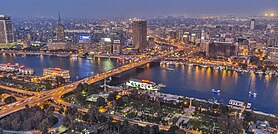Cairo
القاهرة | |
|---|---|
| Nickname: City of a Thousand Minarets | |
| Coordinates: 30°2′40″N 31°14′9″E / 30.04444°N 31.23583°E | |
| Country | Egypt |
| Governorate | Cairo |
| First major foundation | 641–642 AD (Fustat) |
| Last major foundation | 969 AD (Cairo) |
| Government | |
| • Governor | Khaled Abdel Aal[2] |
| Area | |
| • Metro | 2,734 km2 (1,056 sq mi) |
| Elevation | 23 m (75 ft) |
| Population (2018) | |
| 10,100,166[1] | |
| • Density | 3,700/km2 (10,000/sq mi) |
| • Metro | 22,183,000 |
| • Demonym | Cairene |
| GDP | |
| • Capital city | EGP 1,877 billion (US$ 120 billion) |
| • Metro | EGP 2,986 billion (US$ 190 billion) |
| Time zone | UTC+2 (EGY) |
| • Summer (DST) | UTC+3 |
| Area code | (+20) 2 |
| Website | cairo.gov.eg |
| Official name | Historic Cairo |
| Type | Cultural |
| Criteria | i, v, vi |
| Designated | 1979 |
| Reference no. | 89 |
Cairo (/ˈkaɪroʊ/ KY-roh; Arabic: القاهرة, romanized: al-Qāhirah, Egyptian Arabic pronunciation: [el.qɑ(ː)ˈheɾɑ] ) is the capital and largest city of Egypt and the Cairo Governorate, being home to more than 10 million people.[6] It is also part of the largest urban agglomeration in Africa, the Arab world and the Middle East. The Greater Cairo metropolitan area is the 12th-largest in the world by population with over 22.1 million people.[4]
Cairo is associated with ancient Egypt, as the Giza pyramid complex and the ancient cities of Memphis and Heliopolis are located in its geographical area. Located near the Nile Delta,[7][8] the city first developed as Fustat following the Muslim conquest of Egypt in 641 next to an existing ancient Roman fortress, Babylon. Cairo was founded by the Fatimid dynasty in 969. It later superseded Fustat as the main urban centre during the Ayyubid and Mamluk periods (12th–16th centuries).[9] Cairo has long been a centre of the region's political and cultural life, and is titled "the city of a thousand minarets" for its preponderance of Islamic architecture. Cairo's historic center was awarded World Heritage Site status in 1979.[10] Cairo is considered a World City with a "Beta +" classification according to GaWC.[11]
Cairo has the oldest and largest film and music industry in the Arab world, as well as Egypt's oldest institution of higher learning, Al-Azhar University. Many international media, businesses, and organizations have regional headquarters in the city; the Arab League has had its headquarters in Cairo for most of its existence.
Cairo, like many other megacities, suffers from high levels of pollution and traffic. The Cairo Metro, opened in 1987, is the oldest metro system in Africa,[12] and ranks amongst the fifteen busiest in the world,[13] with over 1 billion[14] annual passenger rides. The economy of Cairo was ranked first in the Middle East in 2005,[15] and 43rd globally on Foreign Policy's 2010 Global Cities Index.[16]
- ^ "Population Estimates By Sex & Governorate 1/1/2022* (Theme: Census - pg.4)". Capmas.gov.eg. Archived from the original on 2 November 2018. Retrieved 29 September 2022.
- ^ "Official Portal of Cairo Governorate". Archived from the original on 24 January 2021. Retrieved 12 August 2020.
- ^ "Major Agglomerations of the World - Population Statistics and Maps". City Population. Archived from the original on 11 September 2018. Retrieved 14 November 2022.
- ^ a b "Cairo, Egypt Metro Area Population 1950-2023". Macrotrends. Retrieved 25 February 2023.
- ^ "GDP by governorate", mped.gov.eg, archived from the original on 26 January 2024, retrieved 26 January 2024
- ^ "About Cairo". Cairo Governorate. Archived from the original on 24 March 2023. Retrieved 22 December 2022.
- ^ Santa Maria Tours (4 September 2009). "Cairo – "Al-Qahira" – is Egypt's capital and the largest city in the Middle East and Africa". PRLog. Archived from the original on 30 November 2011. Retrieved 10 December 2011.
- ^ "World's Densest Cities". Forbes. 21 December 2006. Archived from the original on 6 August 2010. Retrieved 6 March 2010.
- ^ Raymond 1993, p. 83-85.
- ^ "Historic Cairo". UNESCO World Heritage Centre. United Nations Educational, Scientific, and Cultural Organization. Archived from the original on 5 June 2017. Retrieved 7 September 2021.
- ^ "The World According to GaWC 2016". Globalization and World Cities Research Network. Loughborough University. 24 April 2017. Archived from the original on 10 October 2013. Retrieved 26 May 2017.
- ^ Transport and Communications, archived from the original on 10 July 2022, retrieved 24 May 2022
- ^ "Cairo's third metro line beats challenges". Archived from the original on 3 July 2017. Retrieved 29 June 2015.
- ^ "Cairo Metro Statistics". Archived from the original on 23 March 2012. Retrieved 4 September 2012.
- ^ "The 150 Richest Cities in the World by GDP in 2005". Archived from the original on 18 September 2012. Retrieved 11 November 2010.
- ^ "The 2010 Global Cities Index". Archived from the original on 2 December 2014.
Cite error: There are <ref group=lower-alpha> tags or {{efn}} templates on this page, but the references will not show without a {{reflist|group=lower-alpha}} template or {{notelist}} template (see the help page).











